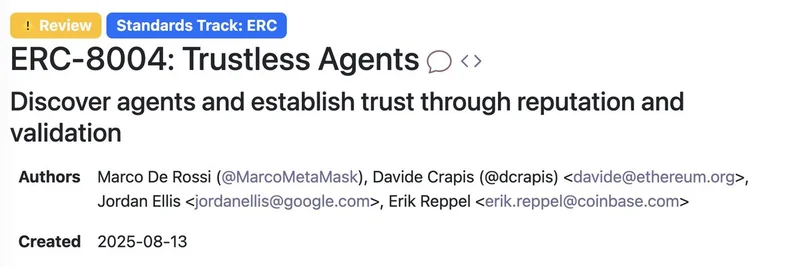Hey there, blockchain enthusiasts! If you've been keeping an eye on the intersection of AI and crypto, you might have caught wind of a game-changing development that's buzzing in the community. A recent tweet from Graeme (@gkisokay) highlights a major leap forward in decentralized AI, or DeAI, with the introduction of ERC-8004 on Ethereum. This standard isn't just another tech update—it's setting the stage for AI agents and even robots to operate in a trustless, on-chain world. Let's dive into what this means, breaking it down step by step.
What is ERC-8004?
At its core, ERC-8004 is an Ethereum Request for Comments (ERC) standard designed to create a trust layer for AI agents. Think of it as a protocol that allows these digital entities—whether they're software-based AI or physical robots—to discover each other, build reputations, and interact without needing a central authority. It's built on top of existing agent communication protocols like Google's Agent-to-Agent (A2A) and adds blockchain magic to make everything verifiable and decentralized.
According to the official EIP-8004 documentation, this standard proposes using blockchains for agent discovery, selection, and interaction across different organizations. It introduces pluggable trust models that scale with the stakes involved—from simple tasks like scheduling a meeting to high-risk ones like financial advice. The authors, including folks from MetaMask, Ethereum Foundation, Google, and Coinbase, have crafted it to foster an open agent economy where trust is earned on-chain.
Key Features Highlighted in the Tweet
Graeme's tweet quoting Marco De Rossi's announcement sums up the excitement perfectly. Here's a breakdown of the five key points he mentioned:
On-Chain Registration for AI Agents and Robots: Agents can now register and list themselves directly on the blockchain. This gives them a unique, portable identity that's resistant to censorship, making it easier for users to find and engage with them.
User Discovery and Rating: People can search for these agents, use their services, and leave ratings based on their experiences. It's like Yelp but on Ethereum, where feedback helps build a reliable ecosystem.
Proof-of-Use in Reviews: Reviews aren't just opinions—they can include verifiable proofs of interaction, adding a layer of authenticity to signal trustworthiness.
Truth Checkers for Accountability: Independent validators, or "truth checkers," ensure honesty by verifying claims and outputs, keeping the system fair and transparent.
Fast and Free Operations: The protocol is optimized for efficiency, meaning interactions are quick and don't come with hefty fees, making it accessible for everyday use.
This setup marks a fresh advancement in AI and robotics, pushing us closer to a future where AI is as decentralized and verifiable as smart contracts.
How ERC-8004 Builds Trust in Decentralized AI
One of the coolest parts of ERC-8004 is its three interconnected registries: Identity, Reputation, and Validation. The Identity Registry uses ERC-721 (think NFTs) to give each agent a unique on-chain handle that points to details like capabilities, endpoints, and supported trust models. The Reputation Registry handles feedback, allowing clients to submit scores and proofs, which can be aggregated for easy trust assessment. Finally, the Validation Registry lets agents request independent checks, like stake-secured re-executions or zero-knowledge proofs, to verify their work.
This tiered approach means you can pick the right level of security for the task at hand. For low-stakes stuff, reputation scores might suffice. For something critical, you could require TEE (Trusted Execution Environment) attestations or zkML (zero-knowledge machine learning) proofs. It's all about making AI agents reliable without relying on big tech gatekeepers.
Why This Matters for the Meme Token Community
Now, you might be wondering how this ties into meme tokens—after all, that's our bread and butter here at Meme Insider. Well, imagine AI agents autonomously trading meme coins, generating viral content, or even managing community DAOs. With ERC-8004, these agents could build on-chain reputations for spotting the next big pump or creating hilarious memes. In the wild world of Solana and Ethereum-based memes, trustworthy AI could help filter out scams, predict trends, or automate airdrops. It's a tool that could supercharge the creativity and efficiency in our space, blending DeAI with the chaotic energy of meme culture.
The Road Ahead for On-Chain AI
As Graeme puts it, this is "another step forward towards a decentralized, verifiable, onchain AI future." With ERC-8004 now live in its v1 form, we're seeing real momentum. Builders are already discussing implementations, and communities like those on Ethereum Magicians are collaborating to refine it further. If you're a developer or just curious, check out the full spec and start experimenting.
What do you think—will ERC-8004 spark the next wave of AI-driven meme innovations? Drop your thoughts in the comments, and stay tuned to Meme Insider for more updates on how blockchain tech is evolving the meme token landscape. 🚀



